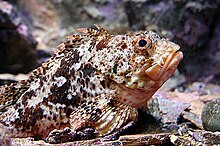en
names in breadcrumbs


The spiny scorpionfish (Trachyscorpia echinata) is a species of marine ray-finned fish belonging to the subfamily Sebastinae, the rockfishes, part of the family Scorpaenidae. It is found in the eastern Atlantic Ocean and the Mediterranean.
The spiny scorpionfish was first formally described as Scorpaena echinata in 1896 by the French zoologist Jean Baptiste François René Koehler with the type locality given as the Bay of Biscay in France.[3] Many authorities regard this taxon as a subspecies of the Atlantic thornyhead (Trachyscorpia cristulata),[4] while others regard it as a synonym of that taxon.[3] This taxon is also placed by some authorities in the subgenus Trachyscorpia. The specific name echinata means "prickly", an allusion Koehler did not explain, but it is likely to be a reference to its spiny ctenoid scales.[5]
The spiny scorpionfish has a large head and orbit and a maximum length of 50 cm (1.6 ft), typically 30 cm (0.98 ft).[6][7] It is reddish with a dusky pigment on back and sides; the dorsal fin is black in males and brown in females.[6]
The spiny scorpionfish lives in the northeast Atlantic Ocean and Mediterranean Sea.[8][9][10][11] It is benthic, living at muddy sand bottoms at depths of 200–2,500 m (660–8,200 ft).[6]
The spiny scorpionfish eats other fish, including eels.[12]
The spiny scorpionfish is oviparous.[13]
 Spiny scorpionfish
Spiny scorpionfish The spiny scorpionfish (Trachyscorpia echinata) is a species of marine ray-finned fish belonging to the subfamily Sebastinae, the rockfishes, part of the family Scorpaenidae. It is found in the eastern Atlantic Ocean and the Mediterranean.
El cabracho de fondo (FAO) Trachyscorpia cristulata echinata es un pez scorpaniforme de la familia Sebastidae. Se le conoce normalmente como cabracho en Galicia y en Cantabria y como tiñoso o tiñosu en Asturias.
El cabracho de fondo posee una cabeza grande, con espinas bien desarrolladas. Sus órbitas oculares son grandes, el puente suborbital es prominente con espinas (el número de espinas aumenta con la edad). Aleta dorsal con 12 espinas y 9 radios blandos, pigmentación oscura (negra en los machos y marrón en las hembras) de la mitad hacia atrás, estas espinas son venenosas, su picadura es muy dolorosa. La aleta pectoral cuenta con 20-23 radios blandos (los más largos cerca de su parte superior); el resto de las aletas son oscuras. La talla máxima descrita es de 50 centímetros.
Habita a profundidades de entre 250 y 2000 metros en el Atlántico Este de Irlanda a Senegal, también habita en el Mediterraneo.
Se suele pescar con palangre de fondo o al arrastre.
Su carne no es tan apreciada como la del cabracho (Scorpaena scrofa).
Especies de interés pesquero en Galicia, Asturias y Cantabria, Eva M. Velasco, Marco A. Amez, Antonio Punzón, Instituto Español de Oceanografía, 2013, ISBN: 978-84-95877-27-7 Depósito Legal: M-35905-2013
El cabracho de fondo (FAO) Trachyscorpia cristulata echinata es un pez scorpaniforme de la familia Sebastidae. Se le conoce normalmente como cabracho en Galicia y en Cantabria y como tiñoso o tiñosu en Asturias.
Trachyscorpia cristulata echinata is een ondersoort van de straalvinnige vissen uit de familie van de schorpioenvissen (Sebastidae).[1] De wetenschappelijke naam van de soort is voor het eerst geldig gepubliceerd in 1896 door Köhler.
Bronnen, noten en/of referenties